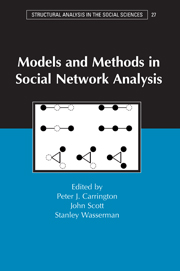Book contents
- Frontmatter
- Contents
- Acknowledgments
- Contributors
- 1 Introduction
- 2 Recent Developments in Network Measurement
- 3 Network Sampling and Model Fitting
- 4 Extending Centrality
- 5 Positional Analyses of Sociometric Data
- 6 Network Models and Methods for Studying the Diffusion of Innovations
- 7 Using Correspondence Analysis for Joint Displays of Affiliation Networks
- 8 An Introduction to Random Graphs, Dependence Graphs, and p*
- 9 Random Graph Models for Social Networks: Multiple Relations or Multiple Raters
- 10 Interdependencies and Social Processes: Dependence Graphs and Generalized Dependence Structures
- 11 Models for Longitudinal Network Data
- 12 Graphic Techniques for Exploring Social Network Data
- 13 Software for Social Network Analysis
- Index
- Structural Analysis in the Social Sciences
13 - Software for Social Network Analysis
Published online by Cambridge University Press: 05 June 2012
- Frontmatter
- Contents
- Acknowledgments
- Contributors
- 1 Introduction
- 2 Recent Developments in Network Measurement
- 3 Network Sampling and Model Fitting
- 4 Extending Centrality
- 5 Positional Analyses of Sociometric Data
- 6 Network Models and Methods for Studying the Diffusion of Innovations
- 7 Using Correspondence Analysis for Joint Displays of Affiliation Networks
- 8 An Introduction to Random Graphs, Dependence Graphs, and p*
- 9 Random Graph Models for Social Networks: Multiple Relations or Multiple Raters
- 10 Interdependencies and Social Processes: Dependence Graphs and Generalized Dependence Structures
- 11 Models for Longitudinal Network Data
- 12 Graphic Techniques for Exploring Social Network Data
- 13 Software for Social Network Analysis
- Index
- Structural Analysis in the Social Sciences
Summary
Introduction
This chapter reviews software for the analysis of social networks. Both commercial and freely available packages are considered. Based on the software page on the INSNA website (http://www.insna.org/INSNA/soft inf.html), and using the main topics in the book on network analysis by Wasserman and Faust (1994), which we regard as the standard text, we selected twenty-seven software packages: twenty-three stand-alone programs, listed in Table 13.1.1, and five utility toolkits given in Table 13.1.2.
Software merely aimed at visualization of networks was not admitted to the list because this is the topic of Chapter 12 of this book (Freeman 2004). We do review a few programs with strong visualization properties. Some were originally developed for network visualization, and now contain analysis procedures (e.g., NetDraw; Borgatti 2002). Other programs were specifically developed to integrate network analysis and visualization (e.g., NetMiner, Cyram 2004, and visone; Brandes and Wagner 2003). Two other programs for network visualization are worth mentioning here because some of the reviewed software packages have export functions to these graph drawing programs, or they are freely distributed together with the social analysis software: KrackPlot (Krackhardt, Blythe, and McGrath 1994) and Mage (Richardson 2001).
The age of the software was not a criterion for selection, although the release dates of the last versions of the majority of the reviewed software were within the last one or two years.
Tables 13.1.1 and 13.1.2 describe the main objective or characteristic of each program.
- Type
- Chapter
- Information
- Models and Methods in Social Network Analysis , pp. 270 - 316Publisher: Cambridge University PressPrint publication year: 2005
- 69
- Cited by



